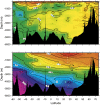Antarctic sea ice control on ocean circulation in present and glacial climates
- PMID: 24889624
- PMCID: PMC4066517
- DOI: 10.1073/pnas.1323922111
Antarctic sea ice control on ocean circulation in present and glacial climates
Abstract
In the modern climate, the ocean below 2 km is mainly filled by waters sinking into the abyss around Antarctica and in the North Atlantic. Paleoproxies indicate that waters of North Atlantic origin were instead absent below 2 km at the Last Glacial Maximum, resulting in an expansion of the volume occupied by Antarctic origin waters. In this study we show that this rearrangement of deep water masses is dynamically linked to the expansion of summer sea ice around Antarctica. A simple theory further suggests that these deep waters only came to the surface under sea ice, which insulated them from atmospheric forcing, and were weakly mixed with overlying waters, thus being able to store carbon for long times. This unappreciated link between the expansion of sea ice and the appearance of a voluminous and insulated water mass may help quantify the ocean's role in regulating atmospheric carbon dioxide on glacial-interglacial timescales. Previous studies pointed to many independent changes in ocean physics to account for the observed swings in atmospheric carbon dioxide. Here it is shown that many of these changes are dynamically linked and therefore must co-occur.
Keywords: Southern Ocean; carbon cycle; ice age; ocean circulation; paleoceanography.
Conflict of interest statement
The authors declare no conflict of interest.
Figures





References
-
- Schneider von Deimling T, Ganopolski A, Held H, Rahmstorf S. How cold was the last glacial maximum? Geophys Res Lett. 2006;33(14):L14709.
-
- Monnin E, et al. Atmospheric CO2 concentrations over the last glacial termination. Science. 2001;291(5501):112–114. - PubMed
-
- Gersonde R, Crosta X, Abelmann A, Armand L. Sea-surface temperature and sea ice distribution of the southern ocean at the EPILOG last glacial maximum—A circum-antarctic view based on siliceous microfossil records. Quat Sci Rev. 2005;24(7-9):869–896.
-
- MARGO Project Members Constraints on the magnitude and patterns of ocean cooling at the last glacial maximum. Nat Geosci. 2009;2:127–132.
-
- Curry WB, Oppo DW. Glacial water mass geometry and the distribution of C of in the western Atlantic Ocean. Paleoceanography. 2005;20(1):PA1017.
Publication types
MeSH terms
LinkOut - more resources
Full Text Sources
Other Literature Sources
Molecular Biology Databases

